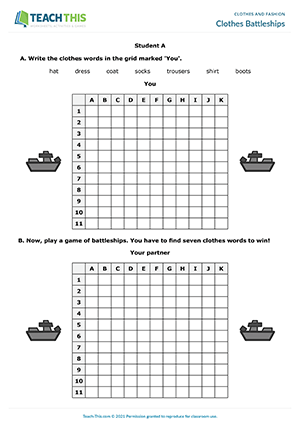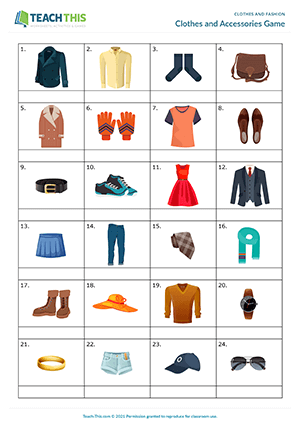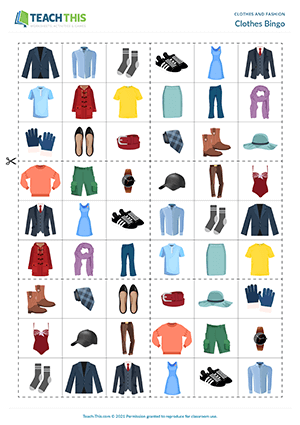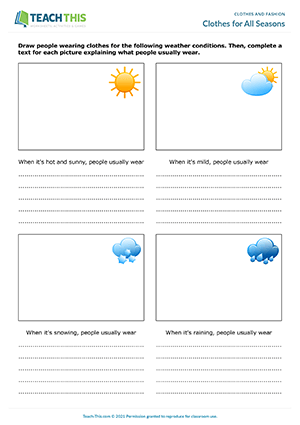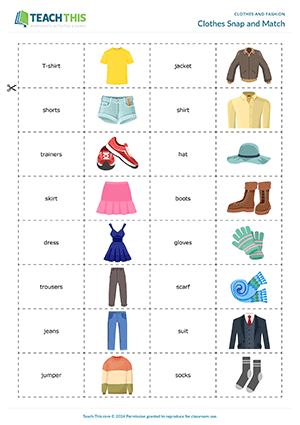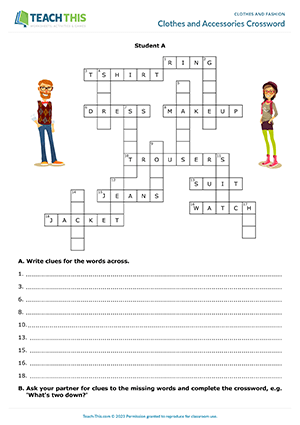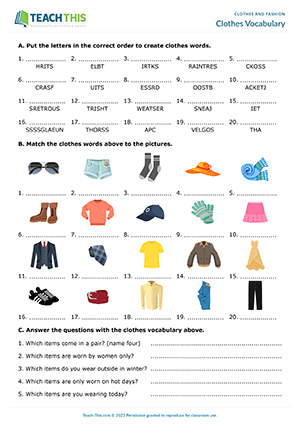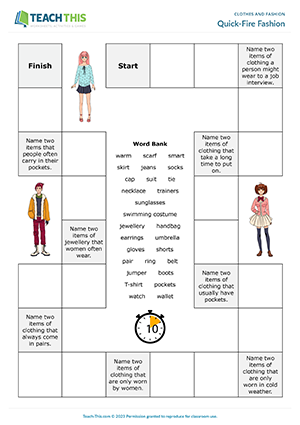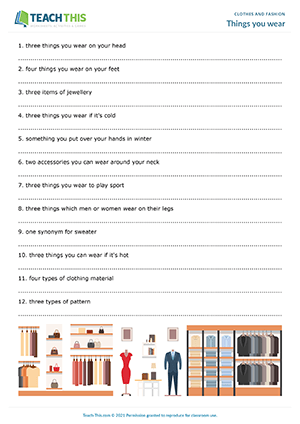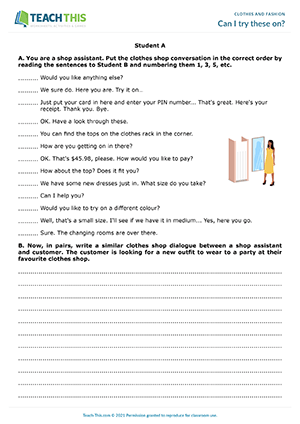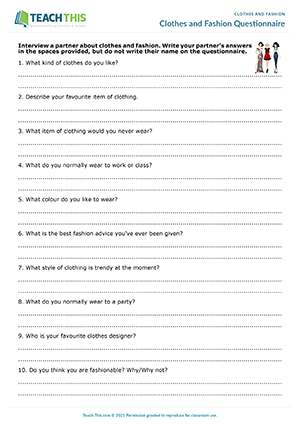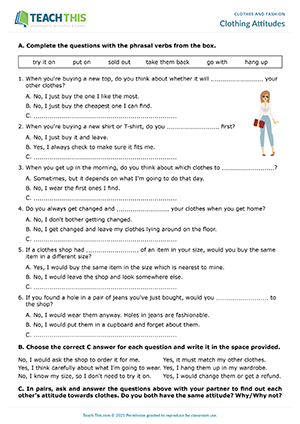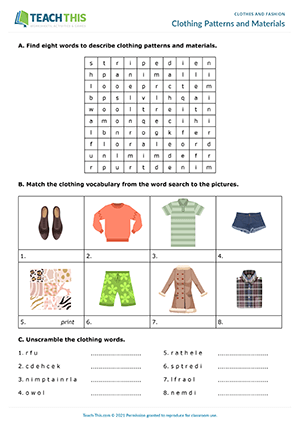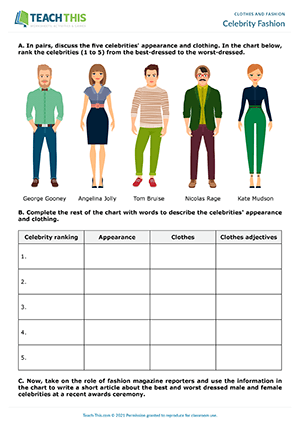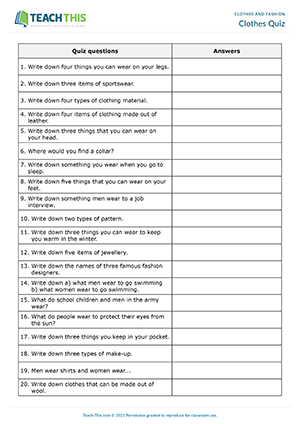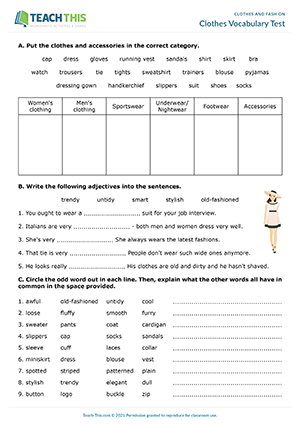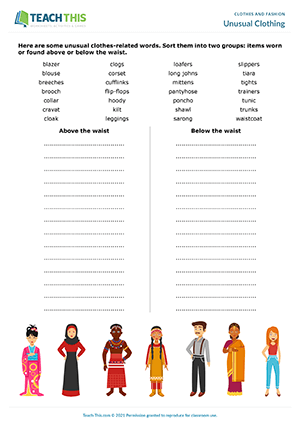In this enjoyable clothes game, students play battleships to practice vocabulary related to clothes. In pairs, students begin by writing seven clothes words somewhere in the grid marked 'You'. Students then take turns calling out coordinates from the 'Your partner' grid on the worksheet, e.g. b 4. If their partner has a letter in that square, they say 'hit' and tell the student the letter. The student then writes the letter in the grid and has another turn. If their partner doesn't have a letter in that square, they say 'miss'. The student then draws an X in the grid and play passes to their partner. The first student to find all seven clothes words wins the game.
In this fun clothes vocabulary game, students match words to pictures of clothes and accessories. In pairs, students take it in turns to pick up a clothes vocabulary card and write the word on the card under the corresponding picture on the worksheet. When the students have completed the worksheet, check the answers with the class. Students score one point for each word they placed correctly and lose one point for each word that is under the wrong picture. The student with the highest score at the end of the game wins.
In this free clothes vocabulary game, students play bingo by listening to clothes words and matching them to pictures. Call out items of clothing in a random order. If students have a matching picture on their bingo card, they cross it out. When a student has crossed out all nine items of clothing, they shout 'Bingo' and say the clothes on their card. If the clothes are correct, the student wins the round. If not, the game continues. Play several rounds with students receiving a different bingo card each time.
In this useful seasonal clothing worksheet, students draw and write about what clothes people wear in different weather conditions. Students begin by drawing pictures of people wearing suitable clothes for each weather condition on the worksheet. Students then complete a text for each picture, explaining what people usually wear. Afterwards, students read their texts to the class.
Here are two imaginative clothes vocabulary games to help students practice the names of different clothes and accessories. Students begin by playing a game of snap. In pairs, students turn over a card from their pile at the same time. If the clothes or accessories word card and picture card match, the first student to say 'Snap' scores a point. Students then pick up their own cards, shuffle them, and play again. If the clothes word and picture don't match, students continue turning over cards until a matching pair comes up and someone says 'Snap'. If a student says 'Snap' when the cards don't match, the other student scores a point, and the game continues. The first student to get ten points wins the game. After that, students move on to play a pelmanism game. Students take turns turning over one word card and one picture card. If the word matches with the picture, the student scores one point and keeps the two cards. For an extra point, the student then tries to make a sentence with the clothes or accessories word. If the student successfully makes a sentence, they have another turn. The student with the most points at the end of the game wins.
In this productive describing clothes activity, students do a crossword where they describe and guess vocabulary for clothes and accessories. In two groups, students invent and write down clues for the clothes and accessories written on their crossword. When the students have finished, they pair up with someone from the other group and take turns asking their partner for a clue to one of their missing words. Their partner reads out the clue for that clothes or accessories word, and the other student tries to guess what it is. If the student guesses the word successfully, they write it on their crossword. If not, their partner continues to give more clues until the student guesses the word. Finally, students check their spelling by comparing crosswords.
This comprehensive clothes vocabulary worksheet helps students learn and practice a variety of common clothes words. Students begin by unscrambling 20 clothes words. Students then match the clothes words to pictures. Next, students answer questions using the clothes vocabulary. After that, students complete a crossword using the clothes words from the worksheet. Lastly, students write down the names of four classmates and describe what each classmate is wearing to a partner without saying their name. Their partner then tries to guess who each person is from the clothes descriptions.
This entertaining clothes and accessories board game helps students practice vocabulary related to clothes, fashion and accessories. In groups, players take turns rolling the dice and moving their counter along the board. If a player lands on a 'Name two' square, they have ten seconds to name two items for the clothes-related category to remain on the square. If they are unsuccessful, they move their counter back two squares. If a player lands on a blank square, another student picks up a card and reads out the sentence using the word 'blank' for the missing clothes-related word, e.g. 'I am wearing a BLANK on my head.' The player then has ten seconds to choose a clothes-related word from the word bank on the game board and say it aloud to complete the sentence, e.g. hat. If the player gives the correct answer, they stay on the square. If not, they move back two spaces. The first player to reach the finish wins the game.
In this engaging clothes vocabulary game, students brainstorm clothes-related vocabulary belonging to different categories. In groups, students have ten minutes to brainstorm and write down clothes vocabulary belonging to the categories shown on the worksheet. When the time limit has been reached, elicit the answers from the students. Groups score one point for each correct answer. The group with the most points wins the game.
In this handy clothes shop activity and role-play, students practice language related to clothes and shopping by putting sentences from a clothes shop conversation in order and then using the language to make a new conversation. Each student has half of a clothes shop conversation, but the sentences are in the wrong order. The students' task is to put the conversation in order by reading the sentences to their partner and numbering them from 1 to 26. Student A is the shop assistant and starts the conversation by looking at their sentences and reading the most suitable one to start the conversation, putting number 1 next to the sentence. Student B, the customer, listens and looks for a suitable reply and then reads that reply to Student A, putting number 2 next to the sentence. This process continues until the conversation has been put in order. Afterwards, pairs write a clothes shop dialogue, similar to the one on the worksheet with one student being the shop assistant and the other the customer. Finally, pairs present their conversations to the class.
In this free clothes and fashion speaking activity, students ask and answer questions about clothes and fashion. In pairs, students interview each other about clothes and fashion and write down their partner's answers in sentence form on the worksheet using the third-person singular. When the students have finished, take back the questionnaires and redistribute them. Students read the answers on the questionnaire they have been given, guess who it belongs to, and check whether they guessed correctly. Afterwards, students give feedback to the class and discuss the answers to the questions.
In this rewarding clothes conversation questions activity, students complete and discuss multiple-choice questions based on clothes and shopping to learn about each other's attitudes towards clothing. To start, students complete multiple-choice questions about clothes and shopping with phrasal verbs from a box on the worksheet. Next, students choose the correct answer for each multiple-choice question and write it in the space provided. In pairs, students then ask and answer the questions from the worksheet with their partner to find out each other's attitudes towards clothes. Afterwards, there is a class feedback session to find out if the students have the same attitudes towards clothes or not.
In this insightful clothes worksheet, students learn and practice eight clothing patterns and materials. To begin, students find eight words to describe clothes patterns and materials in a word search. Next, students match the eight clothing words from the word search to pictures. Students then practice the vocabulary again by unscrambling words. After that, students categorize the eight clothing words into materials or patterns. Students then move on to use their own ideas to write two items of clothing made from each material. In the next exercise, students complete each sentence with a clothing pattern. Students then complete phrases with the clothing vocabulary from the worksheet and draw the corresponding items of clothing. In the last exercise, students describe each item of clothing to a classmate, e.g. 'They are leather boots. It's a striped shirt, etc...'
In this intriguing clothes and fashion activity, students take on the role of fashion magazine reporters and describe the clothes and appearance of five celebrities. In pairs, students look at pictures of celebrities on the worksheet and discuss their appearance and clothing. Students then rank the celebrities from 1 to 5 (best-dressed to worst-dressed) and complete a chart, describing their appearance and clothing. In the appearance column of the chart, students write adjectives to describe the celebrities' general appearance, e.g. smart, glamorous, etc. In the clothes column, students write what each celebrity is wearing. In the last column, students write adjectives to describe the celebrities' clothes, e.g. colourful, casual, etc. After that, students take on the role of fashion magazine reporters and use the information in the chart to write a short article about the best and worst dressed male and female celebrities at a recent awards ceremony. Finally, each pair reads their article to the class.
Here is a creative clothes and fashion quiz game to help students revise vocabulary related to clothing and fashion. Read the first clothes or fashion quiz question to the class. In teams, students discuss the answer to the question and then write it on the worksheet. Then, read out the next question and so on. When all the questions have been answered, the teams swap worksheets for marking. Teams score one point for each correct answer. The team with the most points at the end of the game wins.
This detailed clothes vocabulary worksheets can be used to review clothes vocabulary and adjectives related to clothing, fashion and appearance. Students begin by putting clothes words into their correct category, e.g. women's clothing, footwear, etc. Next, students complete sentences with adjectives related to fashion and appearance. Lastly, students look at sets of four clothes-related words and circle the odd one out. Students then write what the other words all have in common.
In this memorable unusual clothes game, students categorize unusual clothes-related words into items worn or found above or below the waist. Working with a partner, students have ten minutes to categorize the words on the worksheet into items found or worn above or below the waist. When the time limit has been reached, elicit the answers from the students and review the meaning of each word. Pairs score one point for each correct answer. The pair with the most points wins.
Latest Free
Resources
- Everyday Objects Bingo
Everyday Objects
Elementary (A1-A2)
- Action Verb Races
Actions
Elementary (A1-A2)
- Birthday Basics
Birthdays
Elementary (A1-A2)
- Sales Phrasal Verbs
Business Phrasal Verbs
Upper-intermediate (B2)
Latest Member
Resources
- Collocations at Work
Business Collocations
Intermediate (B1)
- Etiquette Trivia Board Game
Etiquette and Manners
Upper-intermediate (B2)
- Everyday Objects Vocabulary
Everyday Objects
Pre-intermediate (A2)
- Let's have a talk
Verb-Noun Collocations
Pre-intermediate (A2)



